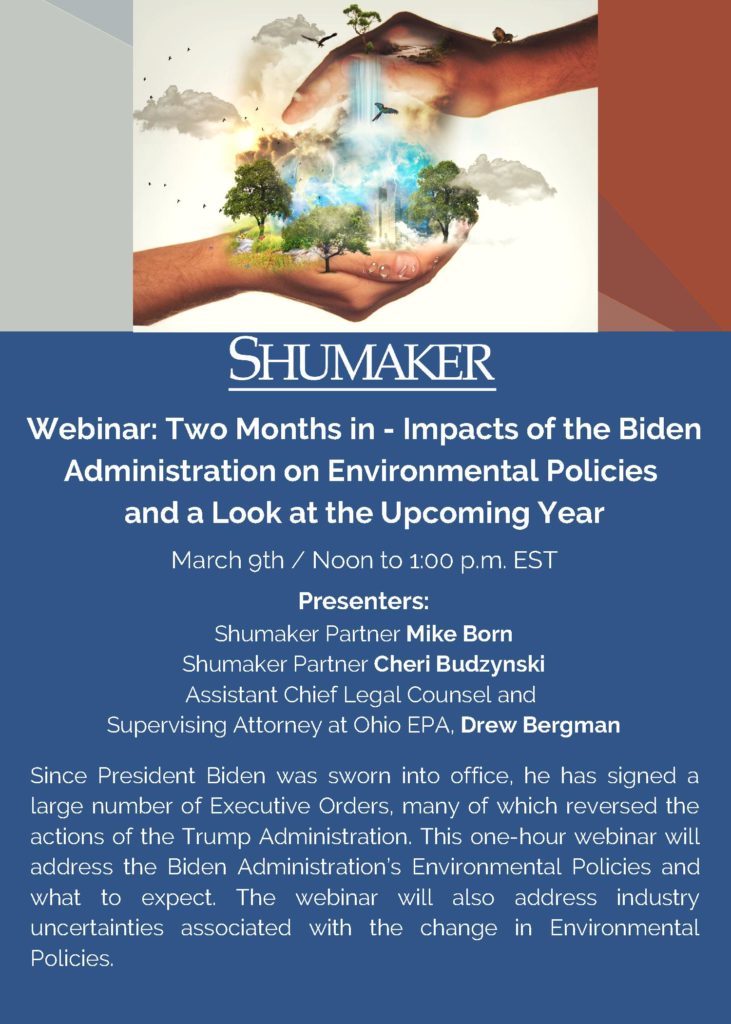Proposed Rules – Beneficial Use Designation Rules (Ohio Administrative Code (“OAC”) 3745-1-11, -12, -19, -23): Ohio EPA, Division of Surface Water, is soliciting input on proposed amendments to four Water Quality Standards rules in OAC Chapter 3745-1. OAC Chapter 3745-1 contains Ohio’s water quality standards, which are state regulations or rules that protect Ohio lakes, rivers, streams, and other surface water bodies from pollution. The proposed rulemaking affects the Maumee, Sandusky, Huron, and Portage river drainage basins. The rulemaking includes three broad types of changes: (1) changing beneficial use designations for specific water bodies; (2) adding water bodies that are currently undesignated to the rule; and (3) verifying existing beneficial use designations already listed in the rule.
The Public Notice is available here. The comment deadline is September 24, 2020. Ohio EPA will be holding a virtual public hearing on the rules at 10:30 a.m. on September 24, 2020. The virtual hearing may be accessed through Ohio EPA’s website at: http://epa.ohio.gov/virtual
Proposed Rules – Credible Data Program (OAC Chapter 3745-4-02,-03,-04,-05,-06): Ohio EPA, Division of Surface Water, is soliciting input on proposed amendments to five Credible Data Program rules in OAC Chapter 3745-4. The proposed updates include several revisions to the collection of data and the administrative aspects of the program, including the extension of timeframes for data submission and updates to definitions, method references (particularly the Field Methods for Evaluating Primary Headwater Streams), and requirements for qualified data collectors.
The Public Notice is available here. The comment deadline is October 8, 2020. Ohio EPA will be holding a virtual public hearing on the rules at 10:30 a.m. on October 8, 2020. The virtual hearing may be accessed through Ohio EPA’s website at: http://epa.ohio.gov/virtual
Public Notice – Final Rulemaking Governing Disadvantaged Community Loans: Ohio EPA, Division of Ground Water, has final filed the following rules of the OAC:
Rule Number: Rule Title:
3745-88-01 Public Notification
3745-88-02 Disinfection of water from surface water sources
The Public Notice is available here. Click above to view the final rule. The rules are effective on September 10, 2020.
Proposal of Rules/Public Hearing Notice – Amended Rules in OAC Chapter 3745-22, Asbestos Licensing Rules: Ohio EPA, Division of Air Pollution Control, under the authority of Sections 3710.02 of the OAC and in accordance with Chapter 119, proposes to amend several rules that are a part of the Ohio EPA Asbestos Licensing/Accreditation Program. The amendments allow Ohio EPA to apply to U.S. EPA for approval of the asbestos licensing program and demonstrate how the program meets the requirements found in the “Asbestos Model Accreditation Plan” 40 CFR part 763, Appendix C to Subpart E. Ohio EPA is proposing to amend the following rules of the OAC:
Rule Number: Rule Title:
3745-22-01 Definitions
3745-22-02 Prohibitions
3745-22-03 General application procedures and provisions for contractors, specialists, designers, air monitors, and workers
3745-22-04 Contractor application requirements, criteria, and standards of conduct
3745-22-05 Asbestos hazard abatement specialist application content, qualifications, standards of conduct
3745-22-06 Asbestos hazard evaluation specialist application content, qualifications, standards of conduct
3745-22-08 Asbestos hazard abatement worker application contents, qualifications, standards of conduct
3745-22-09 Asbestos hazard abatement project designer application content, qualifications, standards of conduct
The Public Notice is available here, and a Rule Synopsis is available here. The Comment deadline is October 9, 2020. Ohio EPA will be holding a virtual public hearing on the proposed amended rules on October 9, 2020 at 10:30 a.m. The meeting will be held exclusively online. During the virtual hearing, the public can submit written comments that will be read into the record by the hearing host. The virtual hearing may be accessed through Ohio EPA’s website at: http://epa.ohio.gov/virtual
Draft Available for Comment – Request for Removal of Rules in OAC Chapter 3745-45 from Ohio’s State Implementation Plan (SIP): Ohio EPA is submitting to the U.S. EPA a request to remove the state-rescinded rules in OAC Chapter 3745-45 from Ohio’s State Implementation plan (SIP).
In 1981, U.S. EPA accepted rules in OAC Chapter 3745-45, “Permit Fees” into Ohio’s SIP to fulfill a requirement for in the Clean Air Act (“the Act”), which required states to collect fees or otherwise have a fee structure in place to ensure that the owner or operator of a source paid fees “…sufficient to cover the reasonable cost of reviewing and acting upon …” permit applications.
In 1995, U.S. EPA approved Ohio’s major source permitting program under Title V of the Act. The fee system in this program replaced the system in OAC Chapter 3745-45, consequently, Ohio rescinded the rules in that Chapter. Ohio neglected to request removal of the rules in OAC Chapter 3745-45 from the SIP at that time. Ohio EPA’s letter serves as that request. A copy of the letter and additional information is available here.
Ohio EPA is seeking public comment to satisfy U.S. EPA requirements for public involvement in SIP related activities in accordance with 40 CFR 51.102. The comment deadline is October 8, 2020.

